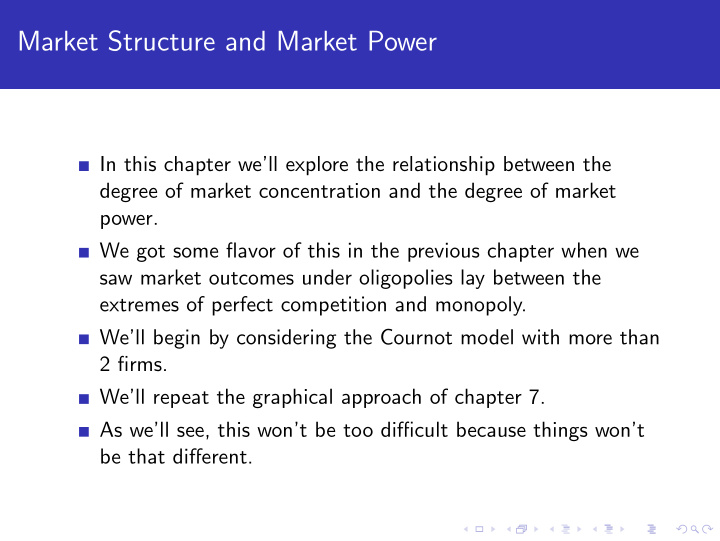



Market Structure and Market Power In this chapter we’ll explore the relationship between the degree of market concentration and the degree of market power. We got some flavor of this in the previous chapter when we saw market outcomes under oligopolies lay between the extremes of perfect competition and monopoly. We’ll begin by considering the Cournot model with more than 2 firms. We’ll repeat the graphical approach of chapter 7. As we’ll see, this won’t be too difficult because things won’t be that different.
Market Structure and Market Power Recall Firm 1’s profit was given by π 1 = P ( Q ) q 1 − cq 1 Q was total industry output. So all that matters matters from this firm’s perspective is the total output produced by other firms, independent of the number of firms. π 1 depends on Q , not n , nor q i , i � = 1. So all we’ll do is replace q 2 in our previous analysis with n � Q − 1 ≡ q i i =2 We will still assume(for now) a symmetric oligopoly in the sense that all firms will produced the same output in equilibrium.
Market Structure and Market Power q N i = q N We’ll solve for q N , first by graphing Firm 1’s reaction curve, noting this time the x axis denotes Q − 1 instead of q 2 . The line is q ∗ 1 ( Q − 1 ). Unlike before, we’ll now add the line beginning at the origin, 1 and with slope n − 1 . Algebraically, this line is denoted by q 1 = Q − 1 / ( n − 1) Why do we need this line? Because an equilibrium output must satisfy two properties.
Market Structure and Market Power Firm 1 chooses optimal output given what the rivals choose, and other firms choose the same output as Firm 1, q i = q 1 . If all other firms choose the same output level as Firm 1 it must be that Q − 1 = ( n − 1) q 1 Therefor, the equilibrium is found by the intersection of the reaction curve and the line q 1 = Q − 1 / ( n − 1) Notice that equilibrium output per firm declines as the the number of firms increases. We are also interested in total industry output as the number of firms increases.
Market Structure and Market Power The axes on the graph give the value of Q − 1 and q 1 . So total industry output is Q − 1 + q 1 . Therefore lines of slope -45 degrees represent points where industry output is the same. We’ll refer to these as iso-output lines. Iso-output lines further away from the origin represent higher values of output. These iso-output lines allow us to draw three conclusions under Cournot equilibrium with n firms.
Market Structure and Market Power Total output is greater than under monopoly but less than perfect competitions, as we showed before. As the number of firms increases, industry output increases. As the number of firms gets arbitrarily large, total output converges to the value under perfect competition. The number of firms for the Cournot equilibrium to be close to the perfect competition model varies with the cost function, elasticity of demand, etc.
Market Concentration and Market Power Previously we measured market power by price cost margin, P − MC and market concentration by the number of firms. Those measures are only useful when the firms have identical cost functions and are the same size. In such heterogeneous settings we need alternative measures. For market power we’ll use the weighted average of each firm’s margin, with weights being market share. This is known as the Lerner index: n p − MC i � L = s i p i =1
Market Concentration and Market Power For concentration, there are various measures. Popular are the C m coefficients: m � C m = s i i =1 where firms are ordered by market shares. An alternative market measure is the Herfindahl index: n � s 2 H = i i =1 As we’ll see later on, H is a better measure of market concentration.
Recommend
More recommend